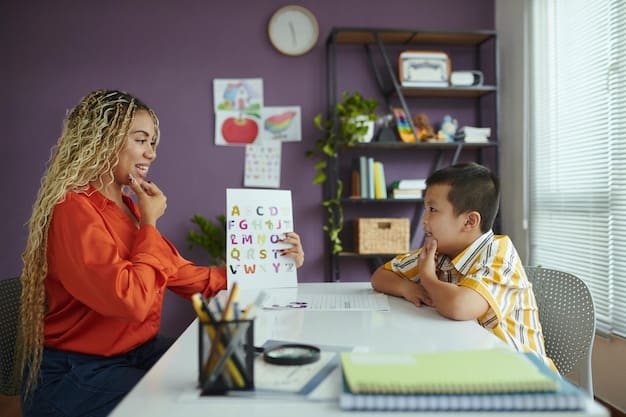Addressing the Achievement Gap: Strategies for Underserved Students

Addressing the achievement gap requires innovative strategies that focus on providing equitable educational opportunities and resources to underserved students, ensuring they have the support needed to succeed academically.
The disparity in academic performance between different groups of students, often referred to as the achievement gap, is a persistent challenge in the US education system. This article explores new strategies to support underserved students and bridge this gap.
Understanding the Achievement Gap
The achievement gap is a multifaceted issue that affects students from various backgrounds, including those from low-income families, minority groups, and students with disabilities. Understanding the root causes of this gap is the first step in developing effective strategies to address it.
Several factors contribute to the achievement gap, including disparities in access to quality education, inadequate resources, and systemic biases. Addressing these issues requires a comprehensive approach that involves schools, communities, and policymakers.
Socioeconomic Factors
Socioeconomic status plays a significant role in academic achievement. Students from low-income families often face challenges such as food insecurity, lack of access to healthcare, and unstable housing, which can negatively impact their ability to succeed in school.
Educational Resources and Funding
Disparities in school funding can lead to unequal access to resources such as qualified teachers, updated textbooks, and فناوری. Schools in wealthier districts often have more resources, providing their students with advantages that underserved students may lack.
- Early Childhood Education: Investing in high-quality early childhood education programs can provide a strong foundation for underserved students.
- Parental Involvement: Engaging parents in their children’s education can improve academic outcomes.
- Mentoring Programs: Providing students with mentors can offer guidance and support.
Addressing the achievement gap requires a commitment to equity and inclusion, ensuring that all students have the opportunity to reach their full potential. By understanding the underlying causes and implementing targeted strategies, we can create a more equitable education system for all.

Innovative Teaching Strategies
Implementing innovative teaching strategies is crucial for engaging underserved students and improving their academic performance. These strategies focus on personalized learning, culturally responsive teaching, and incorporating فناوری into the classroom.
Effective teaching strategies recognize and address the diverse learning needs of students, creating a more inclusive and supportive educational environment. By tailoring instruction to meet individual needs, educators can help students achieve their full potential.
Personalized Learning
Personalized learning involves tailoring instruction to meet the individual needs and interests of each student. This approach recognizes that students learn at different paces and in different ways, and it seeks to provide them with customized learning experiences.
Culturally Responsive Teaching
Culturally responsive teaching incorporates students’ cultural backgrounds and experiences into the curriculum. This approach helps students feel valued and connected to their learning, leading to increased engagement and academic success.
- Project-Based Learning: Engaging students in hands-on projects that connect to real-world problems can increase their motivation and understanding.
- Flipped Classroom: Flipping the classroom allows students to learn at their own pace and provides opportunities for in-class activities and discussions.
- Mastery-Based Learning: Allowing students to progress at their own pace and master concepts before moving on can improve their understanding and retention.
Innovative teaching strategies can transform the classroom into a dynamic and engaging learning environment where all students can thrive. By embracing these approaches, educators can help close the achievement gap and ensure that all students have the opportunity to succeed.
Leveraging فناوری to Bridge the Gap
فناوری can play a transformative role in bridging the achievement gap by providing students with access to personalized learning experiences, online resources, and virtual learning environments. When used effectively, فناوری can enhance instruction and support student success.
Access to فناوری can level the playing field for underserved students, providing them with opportunities to learn and grow that they might not otherwise have. It is essential to ensure that all students have equitable access to فناوری and the training to use it effectively.
Online Learning Platforms
Online learning platforms provide students with access to a wealth of educational resources, including interactive lessons, virtual tutors, and digital libraries. These platforms can be customized to meet the individual needs of students, providing them with personalized learning experiences.
Assistive فناوری
Assistive فناوری can help students with disabilities overcome barriers to learning, providing them with tools and resources to access the curriculum and participate fully in the classroom. This can include software that reads text aloud, speech-to-text software, and adaptive keyboards and mice.
- Virtual Field Trips: فناوری allows students to explore the world from their classroom, providing them with access to experiences that they might not otherwise have.
- Gamification: Incorporating game-based elements into learning can increase student engagement and motivation.
- Data Analytics: Analyzing student data can provide insights into their learning needs and help educators tailor instruction to meet those needs.
Leveraging فناوری can empower underserved students and provide them with the tools and resources they need to succeed. By embracing فناوری and ensuring equitable access for all, we can create a more inclusive and effective education system.

Community and Parental Engagement
Engaging communities and parents is essential for creating a supportive ecosystem that promotes student success. When schools, families, and communities work together, students are more likely to thrive academically, socially, and emotionally.
Community and parental involvement can take many forms, from volunteering in the classroom to participating in school events to providing support and encouragement at home. Building strong relationships between schools and families is crucial for supporting underserved students.
Parent Education Programs
Parent education programs provide parents with the knowledge and skills they need to support their children’s education. These programs can cover topics such as homework help, behavior management, and college preparation.
Community Partnerships
Community partnerships involve collaborations between schools and local organizations, such as businesses, nonprofits, and community centers. These partnerships can provide students with access to resources and opportunities that they might not otherwise have.
- Home Visits: Visiting students’ homes can help educators gain a better understanding of their lives and build stronger relationships with their families.
- Family Literacy Programs: These programs provide families with opportunities to learn together, promoting literacy and strengthening family bonds.
- Community Mentoring Programs: Connecting students with mentors from the community can provide them with guidance and support.
Community and parental engagement is a powerful tool for closing the achievement gap and creating a more equitable education system. By working together, schools, families, and communities can help all students reach their full potential.
Targeted Interventions and Support Systems
Implementing targeted interventions and support systems is critical for addressing the specific needs of underserved students. These interventions should be evidence-based, data-driven, and tailored to meet the unique challenges that students face.
Effective support systems provide students with the resources and guidance they need to overcome barriers to learning and achieve academic success. This includes academic support, social-emotional support, and access to health and wellness services.
Tutoring Programs
Tutoring programs provide students with individualized instruction and support in specific subjects. These programs can help students catch up on missed material, improve their understanding of complex concepts, and build their confidence.
Social-Emotional Learning (SEL)
SEL programs teach students how to manage their emotions, build relationships, and make responsible decisions. These programs can help students develop the social and emotional skills they need to succeed in school and in life.
- Early Warning Systems: These systems use data to identify students who are at risk of falling behind academically or socially.
- Counseling Services: Providing students with access to counseling services can help them address mental health issues and overcome personal challenges.
- Mentoring Programs: Connecting students with mentors can provide them with guidance and support, helping them stay on track and achieve their goals.
Targeted interventions and support systems can make a significant difference in the lives of underserved students. By providing them with the resources and support they need, we can help them overcome barriers to learning and achieve academic success.
Policy and Systemic Changes
Addressing the achievement gap requires policy and systemic changes that promote equity and opportunity for all students. This includes reforming school funding policies, addressing systemic biases, and investing in teacher training and professional development.
Policy changes can create a more level playing field for underserved students, ensuring that they have access to the resources and opportunities they need to succeed. Systemic changes can address the root causes of the achievement gap and create a more equitable education system for all.
Equitable Funding Policies
Reforming school funding policies to ensure that all schools have adequate resources is essential for closing the achievement gap. This can involve redistributing funding from wealthier districts to poorer districts, or implementing funding formulas that take into account the needs of underserved students.
Addressing Systemic Biases
Addressing systemic biases in the education system is critical for creating a more equitable learning environment for all students. This includes addressing issues such as racial bias, stereotype threat, and implicit bias in teaching practices.
- Teacher Training and Professional Development: Investing in teacher training and professional development can help educators develop the skills and knowledge they need to effectively teach underserved students.
- Accountability Measures: Implementing accountability measures that track the progress of underserved students can help ensure that schools are meeting their needs.
- Community Involvement in Policymaking: Engaging communities in the policymaking process can help ensure that policies are responsive to the needs of underserved students.
Policy and systemic changes are essential for creating a more equitable education system and closing the achievement gap. By addressing the root causes of the gap and implementing evidence-based policies, we can create a system that works for all students.
| Key Point | Brief Description |
|---|---|
| 🎓 Innovative Teaching | Personalized, culturally responsive methods maximize engagement. |
| 💻 Leveraging Technology | Online platforms & assistive devices bridge resource gaps. |
| 🤝 Community & Parents | Engagement strengthens student support networks. |
| 🎯 Targeted Support | Interventions cater to individual student challenges. |
About the Achievement Gap
▼
The achievement gap refers to the disparity in academic performance between different groups of students, such as those from different racial, ethnic, or socioeconomic backgrounds.
▼
Several factors contribute to the achievement gap, including disparities in access to resources, systemic biases, socioeconomic factors, and unequal educational opportunities.
▼
Innovative strategies like personalized learning and culturally responsive teaching can engage students and address their diverse learning needs, fostering a more inclusive environment.
▼
Technology can provide access to personalized learning and virtual resources, enhance instruction, and help level the playing field for underserved students and students with disabilities.
▼
Engaging communities and parents creates a stronger support system that promotes student success through collaboration, resources, encouragement, and involvement in education.
Conclusion
Addressing the achievement gap requires a multifaceted approach that includes innovative teaching strategies, leveraging فناوری, community and parental engagement, targeted interventions, and policy changes. By working together, educators, policymakers, families, and communities can create a more equitable education system that provides all students with the opportunity to succeed.





